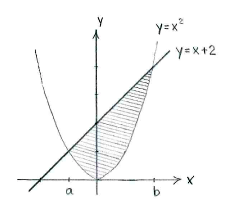Lösung 2.1:4e
Aus Online Mathematik Brückenkurs 2
| (Der Versionsvergleich bezieht 5 dazwischen liegende Versionen mit ein.) | |||
| Zeile 1: | Zeile 1: | ||
| - | + | Die doppelte Ungleichung bedeutet, dass ''y'' zwischen den Kurven <math>y=x+2</math> und <math>y=x^2</math> liegt. | |
| - | <math>y=x+ | + | |
| - | + | ||
| - | <math>y=x^ | + | |
| - | + | ||
| - | + | ||
| - | + | ||
| + | In der Figur unten ist das Gebiet eingezeichnet. | ||
[[Image:2_1_4_e.gif|center]] | [[Image:2_1_4_e.gif|center]] | ||
| + | Die Fläche des Gebietes ist | ||
| - | + | {{Abgesetzte Formel||<math>\text{Fläche} = \int\limits_a^b \bigl(x+2-x^2\bigr)\,dx\,\textrm{,}</math>}} | |
| - | <math>x | + | |
| - | - | + | |
| - | + | ||
| - | + | ||
| - | + | ||
| - | + | ||
| - | + | ||
| - | + | wobei <math>x=a</math> und <math>x=b</math> die Schnittstellen der beiden Kurven sind, die wir durch folgende Gleichung erhalten | |
| - | <math> | + | |
| + | {{Abgesetzte Formel||<math>\left\{\begin{align} | ||
| + | y &= x+2\,,\\[5pt] | ||
| + | y &= x^2\,\textrm{.} | ||
| + | \end{align} \right.</math>}} | ||
| - | + | Eliminieren wir <math>y</math>, erhalten wir für <math>x</math> diese Gleichung | |
| - | + | ||
| - | + | ||
| - | + | ||
| - | + | ||
| - | + | ||
| - | + | ||
| - | + | ||
| - | + | ||
| - | + | ||
| - | <math>y</math>, | + | |
| - | <math>x</math> | + | |
| + | {{Abgesetzte Formel||<math>x^{2}=x+2\,\textrm{.}</math>}} | ||
| - | + | Hohlen wir alle ''x''-Terme zu einer Seite erhalten wir | |
| - | + | ||
| - | + | ||
| - | + | ||
| - | + | ||
| - | + | ||
| - | + | ||
| - | + | ||
| - | + | ||
| - | + | ||
| + | {{Abgesetzte Formel||<math>x^2-x=2\,</math>.}} | ||
| - | + | Durch quadratische Ergänzung ergibt sich | |
| - | + | ||
| - | + | ||
| - | + | ||
| - | + | {{Abgesetzte Formel||<math>\begin{align} | |
| - | <math>x | + | \Bigl(x-\frac{1}{2}\Bigr)^2 - \Bigl(\frac{1}{2}\Bigr)^2 &= 2\\[5pt] |
| - | + | \Bigl(x-\frac{1}{2}\Bigr)^2 &= \frac{9}{4}\,\textrm{.} | |
| - | + | \end{align}</math>}} | |
| - | + | ||
| - | + | Wir erhalten also die Wurzeln <math>x=\tfrac{1}{2}\pm \tfrac{3}{2}</math>, oder <math>x=-1</math> und <math>x=2\,</math>. | |
| + | Die Fläche ist also | ||
| - | <math>\begin{align} | + | {{Abgesetzte Formel||<math>\begin{align} |
| - | + | \text{Fläche} | |
| - | & =\frac{2^ | + | &= \int\limits_{-1}^2 \bigl(x+2-x^2\bigr)\,dx\\[5pt] |
| - | & =2+4-\frac{8}{3}-\frac{1}{2}+2-\frac{1}{3} \\ | + | &= \Bigl[\ \frac{x^2}{2} + 2x - \frac{x^3}{3}\ \Bigr]_{-1}^2\\[5pt] |
| - | & =\frac{9}{2} \\ | + | &= \frac{2^2}{2} + 2\cdot 2 - \frac{2^3}{3} - \Bigl( \frac{(-1)^2}{2} + 2\cdot (-1) - \frac{(-1)^3}{3}\Bigr)\\[5pt] |
| - | \end{align}</math> | + | &= 2 + 4 - \frac{8}{3} - \frac{1}{2} + 2 - \frac{1}{3}\\[5pt] |
| + | &= \frac{9}{2}\,\textrm{.} | ||
| + | \end{align}</math>}} | ||
Aktuelle Version
Die doppelte Ungleichung bedeutet, dass y zwischen den Kurven \displaystyle y=x+2 und \displaystyle y=x^2 liegt.
In der Figur unten ist das Gebiet eingezeichnet.
Die Fläche des Gebietes ist
| \displaystyle \text{Fläche} = \int\limits_a^b \bigl(x+2-x^2\bigr)\,dx\,\textrm{,} |
wobei \displaystyle x=a und \displaystyle x=b die Schnittstellen der beiden Kurven sind, die wir durch folgende Gleichung erhalten
| \displaystyle \left\{\begin{align}
y &= x+2\,,\\[5pt] y &= x^2\,\textrm{.} \end{align} \right. |
Eliminieren wir \displaystyle y, erhalten wir für \displaystyle x diese Gleichung
| \displaystyle x^{2}=x+2\,\textrm{.} |
Hohlen wir alle x-Terme zu einer Seite erhalten wir
| \displaystyle x^2-x=2\,. |
Durch quadratische Ergänzung ergibt sich
| \displaystyle \begin{align}
\Bigl(x-\frac{1}{2}\Bigr)^2 - \Bigl(\frac{1}{2}\Bigr)^2 &= 2\\[5pt] \Bigl(x-\frac{1}{2}\Bigr)^2 &= \frac{9}{4}\,\textrm{.} \end{align} |
Wir erhalten also die Wurzeln \displaystyle x=\tfrac{1}{2}\pm \tfrac{3}{2}, oder \displaystyle x=-1 und \displaystyle x=2\,.
Die Fläche ist also
| \displaystyle \begin{align}
\text{Fläche} &= \int\limits_{-1}^2 \bigl(x+2-x^2\bigr)\,dx\\[5pt] &= \Bigl[\ \frac{x^2}{2} + 2x - \frac{x^3}{3}\ \Bigr]_{-1}^2\\[5pt] &= \frac{2^2}{2} + 2\cdot 2 - \frac{2^3}{3} - \Bigl( \frac{(-1)^2}{2} + 2\cdot (-1) - \frac{(-1)^3}{3}\Bigr)\\[5pt] &= 2 + 4 - \frac{8}{3} - \frac{1}{2} + 2 - \frac{1}{3}\\[5pt] &= \frac{9}{2}\,\textrm{.} \end{align} |

